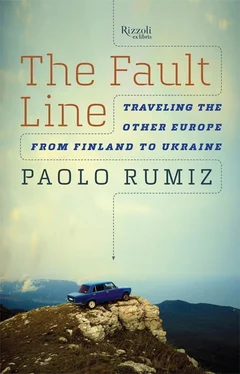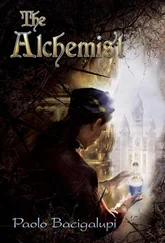I think back to what I saw on the Solovetsky Islands. That’s where I put away forever the stereotype that sees Orthodox iconography as something cold, algebraic, obsessively conservative, immutable, and fixed to its Greek archetype.
Instead, on the monastery islands in the middle of the White Sea, I saw the explosion of a decorative art that was warm, almost floral, of an unexpected and overflowing physicality, even similar, at times, to the images of the rubicund cherubim that you see in certain Alpine manger scenes. In the land of the long winters, the medieval was grafted onto the Baroque without passing through the Renaissance, whose carnal verisimilitude was incompatible with the Orthodox soul, much less with the spare solemnity of its origins.
After opening the books of the Kalevala , I am crossing the Onega with the sensation of a new epiphany coming to fruition. I think again of the royal doors, those openings in the iconostasis, where the faithful can peek through and see, beyond the isthmus that divides (or joins) Heaven and Earth, the terrible instant of the sacrifice, with the knife of the pope cutting into the bread. The doors were the hinges of Eastern spirituality, far more mystical than ours, and the abbot Pavel Florensky—executed by Stalin in 1937—defined their symbolic meaning with Pythagorean precision. But it is not true that the royal doors were initially decorated only with pictorial representations. As early as the thirteenth century, in Hilandar, and later in Novgorod, Pskov, and even Ioannina, capital of Epirus, there were doors enriched with bone inlays or wooden reliefs of torches, garlands, fabulous leopards, or birds-of-paradise.
I look out at the endless forests and think that much of this production in wood is rooted in the Russian tradition of the cult of the tree, great symbol of the sacred. The tree, with its roots that reach down into the shadows of the nether regions and its leaves that open toward the light of the cosmos. The tree as the chaos of the primordial forest but also as the order of creation; as original sin (the forbidden tree of knowledge) but also as flaming pilaster planted in the middle of celestial Jerusalem, precursor of the victorious cross. This could already be seen in Bulgaria before the year 1000.
The body of Nicholas of Myra, Eastern Orthodoxy’s saint of saints, is replaced in the Russian world by statues, which are the repositories of the same extraordinary miraculous expectations that surround his mummy preserved in the cathedral in Bari. In carved icons from the sixteenth century on, the “source image” from Bari is always present. In general, statues of saints were not only objects of veneration, but also of ire, in the case of unfilled expectations on the part of the faithful. In Sicily, it was customary to put a salted sardine in the mouth of a saint who had failed to interrupt a drought. In Russia, worse things happened: Ivan the Terrible had the statue of Nicholas of Mozhaisk beaten with a cane, guilty—so the czar said—of having supported his Lithuanian enemies.
Some years ago, at a magnificent exhibition of Russian wood sculpture in Vicenza, I saw the statue of Saint Nil Sorsky (Nilus of Sora), who died in 1554 on the river island where he had spent his life in prayer, in opposition to the vast accumulation of wealth in land and serfs owned by the Church and monasteries.
It is said that, sensing his end was near, he dug his own grave and lay down inside it, but then, as the moment of passage was beginning, he reemerged with a terrible strength, pulling himself up on crutches in order to die sitting down. For penance, he had decided that he would never lie down while alive, and death caught him in a posture coherent with this choice. The statue I saw showed him on his knees, eyes closed, crutches coming out of his armpits, with a talismanic force rivaling any two-dimensional painting.
In 2005, in Greece, I saw Saint Parasceve (Agia Paraskevi), protectress of the waters and of fertility, virtually unknown in the Catholic world. I saw her in a convent dedicated to her name and populated with fantastic floral images, as well as peacocks and all kinds of birds, which, according to their pious caretakers, were meant to represent the Garden of Eden. On the mountains near the Bulgarian border, that dark icon with two sweet eyes looked out at me from the semidarkness, from the other side of a mountain of silver offerings for grace received and a wall of jewel cases jammed with relics mounted on silver studs. She struck me dumb with her helpless grace, reincarnated in the superb sweetness of a woman of the East.
The landing dock in Petrozavodsk is almost Finland. Faces that are rounder and more washed out, the monumental cleanliness of the historic center, and people conversing in a muffled, almost whispered, chirping. Full-bore West: rushing professionals armed with briefcases, androgynous women on cell phones, the Latin alphabet again on billboards, and a never seen density of ATMs, able to distribute—get this—dollars! In the Internet cafés, there’s even something resembling a middle class. The only genuine hotel, a ship named Debarkader , outfitted for overnight stays and moored at the pier, is booked up, so we’re forced to resort to the pretentious Kareliya, with its higher-than-market rates and the inevitable, irritating tomblike marble, an affront to the millennial culture of birchwood. I should feel right at home, but instead I can feel my heart tighten. It seems that our adventure is already over.
But luckily, on the lakeshore walk, there’s Anatoly Fyodorovich, who squeezes melancholy from his accordion, sitting on the wall between miniskirted girls with strawberry lips. Monika translates the heartrending verses, such as “The train leaves and you’re all alone in a cloud of snow.” Instead of a hat for donations there’s a margarine tub. I drop in fifty rubles (four dollars) and Anatoly goes crazy, singing the old favorite “Katyusha” in a klezmer arrangement. It’s Saturday, the whole city is on the waterfront for the evening stroll, and a quartet of lovely ladies out on their own surround the accordion player and sweet-talk him: “Come on, play us ‘The Gypsy Girl,’” and then they start dancing with their arms spread wide, tapping their high heels, in a circle, Greek style. And when our guy squeezes out from his bellows “Other Peoples’ Weddings,” a hammer blow of melancholy that would knock out a bull, they pretend to be upset: “It’s so sad, damn you. But we’ll pay you just the same.” Naturally, they keep on dancing, tied together in a tango, and laughing heartily.
Old Russia, stand firm. Once, during stopovers in these ports, characters like Anatoly boarded cruise ships with painters and cantors, to bring a little of their culture to the passengers. Today, under Putin, the onboard entertainment is karaoke and the Miss Cruise Ship contest, and the “new Russians” are ashamed of their pioneer tradition. One time, during a cruise on the White Sea, an Italian friend of mine named Marina was invited to come up to the microphone and sing. When she started to sing the Italian Communist resistance anthem, “Bella ciao,” she could see the chill come over the faces of her Muscovite dinner companions and the total indifference of the Americans who were eating with them. When she protested against the waste of food by the newly rich passengers, who at breakfast threw handfuls of whipped cream and chocolate at one another, overturning trays of food, she was pushed and shoved and threatened, while not one member of the staff or crew came to defend her.
Alya Andreyevna, seventy-four, a widow, sky-blue eyes and dress, is cut from a whole different cloth. She appears like an angel at the front door of her house, at the end of Prospekt Kommunistov, an old-fashioned street with wooden houses and backyards, which we are walking down in search of the real Russia. This woman, whom we will always remember as “the queen of the blini”—the legendary Russian crepes—is chatting with one of her neighbors, Sofia Pavlovna, and can’t resist the desire to invite the foreigners to her house for tea. All around her, cats and happy children chase each other among the woodsheds and the well-kept lawns of the condominium. In simple words, she tells us the genesis and the denouement of her world.
Читать дальше












